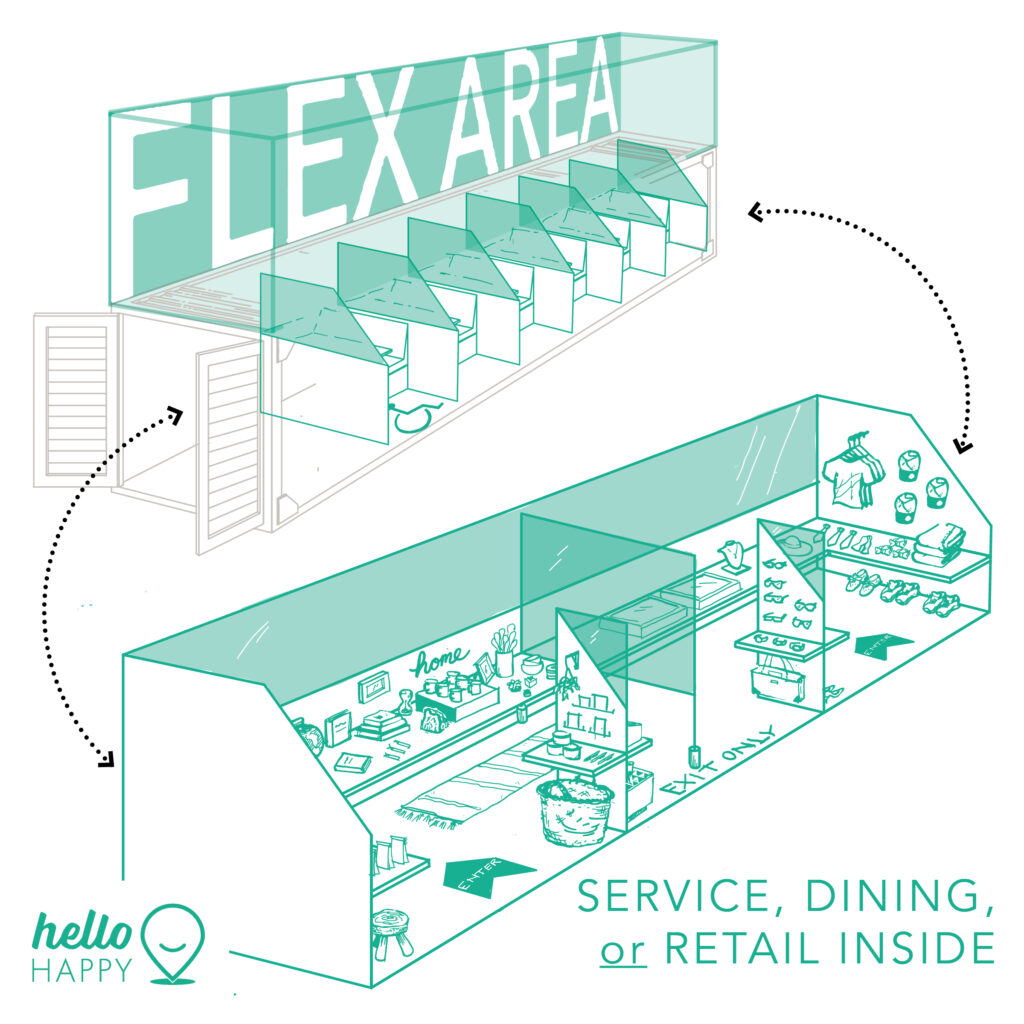Recently, Baltimore City launched their Design for Distancing competition seeking creative, tactical, and modular ideas for safely reopening businesses and public spaces during the Covid-19 pandemic.
Below are four submissions from Hello Happy Design!
The Rest-ibule
Each winter, little vestibules pop-up across the city—protruding beyond a restaurant’s façade, insulating the entrance. Interestingly, these temporary vestibules present opportunities beyond weatherization: controlled carry-out zones.
Taking into consideration the existing façade and available sidewalk space, businesses select from three pre-fab designs. The smallest uses a single, primary ingress/egress as a carry-out window where a Dutch door opens the threshold between customer and cashier without blocking fire access.The largest option offers designated order/pick-up windows and a deeper footprint to accommodate a “touchless” double-acting door. Once inside the vestibule, staff and visitors can sanitize their hands and belongings or access face masks to limit contaminants before entering the restaurant.
As a standalone unit at key commercial nodes, the vestibules serve as a consolidated local delivery order hub which, when paired with food service delivery regulations, can protect small businesses from excessive costs of working with third-party delivery services.
Bubblemore
Life doesn’t happen in a bubble.
. . . or does it?
#Stayathome orders, which have been absolutely necessary for flattening the curve, have misled some of us into believing physical distancing requires social distancing. Our social connections, however, are crucial when we think about strengthening our communities. It is critical, therefore, to find ways to safely congregate in small gatherings and celebrate culture and community.
The public realm is where we unite. Bubblemore facilitates community connections by clustering vented bubbles for small groups enjoying public places and events. Upon existing, infrared sensors initiate a sanitization process by triggering battery-powered, electrostatic disinfectant sprayers. The Bubblemore Bubbles become Baltimore’s outdoor living rooms.
They facilitate safe social gathering—whether in the form of a family picnic or a neighborhood concert in the park—so that we may contain the spread of the virus while our vibrant communities burst back to life.
Healthy + Hygge Huts
Open air shopping and dining, we know, poses less risk than strolling inside a dense shopping mall or big box store. There’s no reason Baltimore can’t enjoy the same inviting streetscape year-round, just like the Danes.
Copenhagen is known for its outdoor dining and markets, yet the city is colder on average and sees more days of precipitation each year compared to Baltimore. The key is in how the Danish create “hygge” — that is, cozy — experiences. This modular hut is designed to fit anywhere, from park places to parking spaces. Restaurants and stores can enjoy their own unique front porch or share a larger cluster of huts with neighboring businesses.
The hut’s simple cube frame easily collapses for storage, and offers a sturdy base upon which roof designs, outer shells, and interior accessories can be customized to reflect a businesses personality and create comfortable interior climates for patrons.
Healthy + Hygge Hut v2.0
Version 2.0 of the Hygge Hut maximizes space and effectively doubles the limited square footage available in the public realm. How? By expanding vertically.
Port cities like Baltimore offer an abundant resource that’s easily customized, completely standardized, and strong enough to support upward expansion: shipping containers.
The weather-proofed interior of shipping containers solves for climate control, offering respite from the elements. Furthermore, the durable structure can be secured each night to protect merchandise. The space above the container presents flexibility. It might be an open-air dining experience affording adequate space between patrons, or a venue for small-group programming—such as yoga classes or neighborhood meetings. Alternatively, the upper area can support solar panels, parklet space, or a green roof to alleviate urban heat island. By taking advantage of vertical space, this double-decked and multipurpose container maximizes area available area for multiple businesses, community groups, and residents on a single block.

















